
 |
|
#1
|
|||
|
|||
|
When I was routing the purfling rim, the vibrations caused the ball bearing which was probably not screwed tightly to come off and rush violently over the back of the guitar. There it has dug its way into the Tineo wood leaving a "beautiful" wing-like figure. After that it has landed somewhere in my room. Despite multiple searches, I have not (yet) found it. I will definitely see it again when its replacement arrives at my place.
 My question: How can I make this stupid structure "invisible"? The paint is clear nitro lacquer. I've already thought of turning it into an embedded bird's wing of abalone - or with several pieces of veneer. Maybe someone has another brilliant tip here? I don't want to rebuild the back, = too much effort. By the way, I´ll keep this guitar for myself. I can live with inadequacy (= custom made !  ...as long as it sounds good. ...as long as it sounds good.in mm: 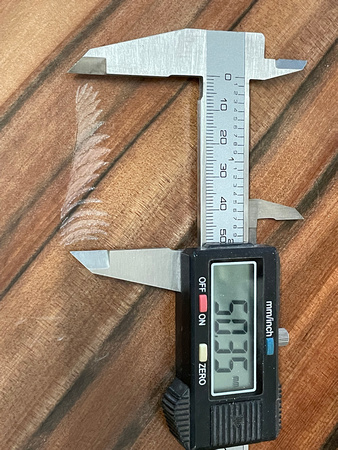
__________________
Thanks!  Martin D28 (1973) 12-string cutaway ...finished ;-) Hoyer 12-string (1965) Yamaha FG-340 (1970) Yamaha FG-512 (ca. 1980) D.Maurer 8-string baritone (2013-2014) and 4 electric axes |
|
#2
|
|||
|
|||
|
Is there enough thickness in your back to just scape and sand it out? How deep is the scratch?
|
|
#3
|
|||
|
|||
|
I'd like to see whether a patch on the inside can allow scraping/sanding to remove the gouges and keep the wood in the damaged area stiff. A big patch.
|
|
#4
|
|||
|
|||
|
It's safe to assume that there is no finish on the guitar yet.
I would wet the area to raise the grain if you had not raised it prior, and then sand & scrap it flat, but over a 'larger' area so that you're not creating such a sudden dip in the surface. The abrasions are probably not as deep as it presents visually. Tighten that bearing. Regards, Howard Emerson
__________________
My New Website! |
|
#5
|
|||
|
|||
|
If it will take stain, come up with a good story like it is a feather from an eagle that got embedded in the tree as it was growing. Stain it dark like the darker stripes already there, cover with clear coat and call it unique. If people buy that story, run for office.
|
|
#6
|
|||
|
|||
|
So it already has nitro on it? How deep is it? From the pics it looks like you may be able to steam it to puff it up a bit then sand flush again.
|
|
#7
|
||||
|
||||
|
I believe thin spots are a problem on guitar plates, manifesting as imbalance and distortion. I would leave it alone if it were mine, and not for a customer. If it were for a customer I would try to get them to accept it. As it happens, that is a relatively attractive blemish!!!
|
|
#8
|
|||
|
|||
|
I think its beautiful. Call it a feature and up charge to replicate it.
__________________
BradHall _____________________ |
|
#9
|
|||
|
|||
|
As the scratch is about 0.5 millimeters deep (=5/254 inches) it isn´t secure to scrape and sand it out.
Therefore wetting and sanding the grain is no option as well. Staining dark would be an option, much easier than making any inlay be it abalone or veneer. I´d rather tend to veneer which is not as strong a contrast as abalone. It blends in more with the surrounding wood. Bruce, you´re right, as it is a "relatively attractive blemish" I would have to bring it up to the surrounding level. Maybe with some clear filling...epoxy or several layers of nitro lacquer? That seems to be the simplest solution without much change or work. And next time I will definitely keep an eye on tightening that **** ball bearing. 
__________________
Thanks!  Martin D28 (1973) 12-string cutaway ...finished ;-) Hoyer 12-string (1965) Yamaha FG-340 (1970) Yamaha FG-512 (ca. 1980) D.Maurer 8-string baritone (2013-2014) and 4 electric axes |
|
#10
|
|||
|
|||
|
Looks like something you couldn't do on purpose no matter how skilled one was. Might fill it with some pearl/colored stuff used with epoxy, could be a chance to learn a new skill since you are keeping it.
|
|
#11
|
|||
|
|||
|
I´ve sanded down the scratches a little and then filled them with super glue.
Here is the intermediate result: 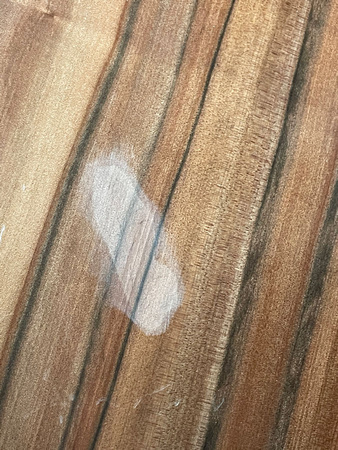 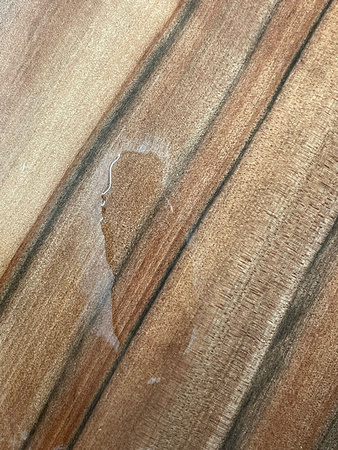 When dried and painted with nitro, I´ll take aother picture. It seems to be going great!
__________________
Thanks!  Martin D28 (1973) 12-string cutaway ...finished ;-) Hoyer 12-string (1965) Yamaha FG-340 (1970) Yamaha FG-512 (ca. 1980) D.Maurer 8-string baritone (2013-2014) and 4 electric axes |
|
#12
|
|||
|
|||
|
The penultimate state before spraying shows a dark spot, which is still noticeable after scraping with a razor blade
and then sanding with sandpaper (180 and then with 400 grit). I sanded the back and the sides with it. But I think that it should go away with nitrocellulose spray. I'm just waiting for a little less moisture in the air. 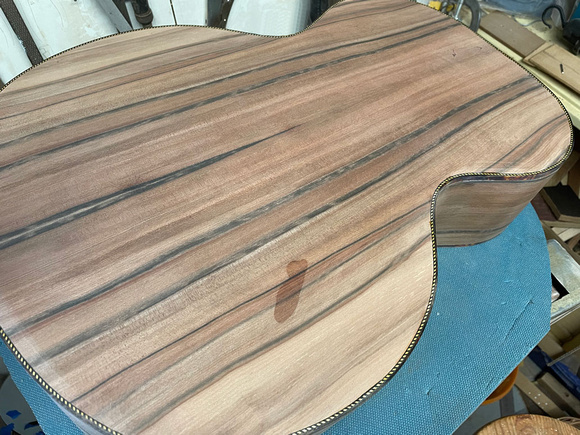 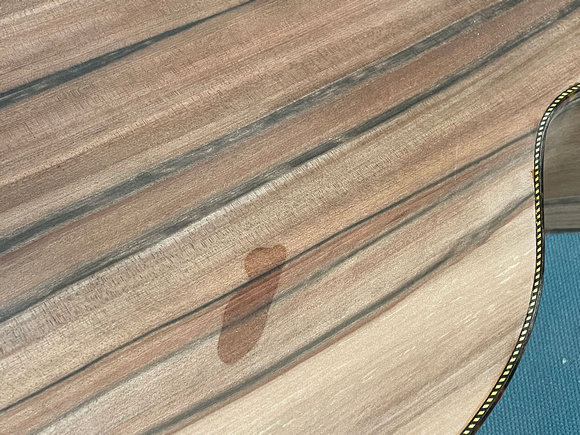
__________________
Thanks!  Martin D28 (1973) 12-string cutaway ...finished ;-) Hoyer 12-string (1965) Yamaha FG-340 (1970) Yamaha FG-512 (ca. 1980) D.Maurer 8-string baritone (2013-2014) and 4 electric axes Last edited by viento; 07-29-2021 at 03:36 AM. |
|
#13
|
|||
|
|||
|
That's looking pretty good. One thing you may consider is filling the entire guitar with CA. CA makes a great filler imho and that might help hide the whole thing. Though as you say that very well may go away under Nitro but you will only know that once you try.
|
|
#14
|
|||
|
|||
|
OP's picture is of a low spot, caused by his wayward router bit and the local sanding done to remove the gouges. Wood was removed. The shiny spot is evidence of that low spot, untouched by sanding when the back was blocksanded. My opinion is to build up a dam around the spot with masking tape and fill the spot with epoxy, until blocksanding shows no low spots and the surface is level.
|
|
#15
|
|||
|
|||
|
@redir: I´ll give it a try and touch a spot adjacent to the CA area with nitro. Then I will see if the filled area still is visible.
Maybe it´s not visible in the last photo but the filled (=darker) area is level with the surrounding wood. No difference can be felt when running the hand over it.
__________________
Thanks!  Martin D28 (1973) 12-string cutaway ...finished ;-) Hoyer 12-string (1965) Yamaha FG-340 (1970) Yamaha FG-512 (ca. 1980) D.Maurer 8-string baritone (2013-2014) and 4 electric axes |